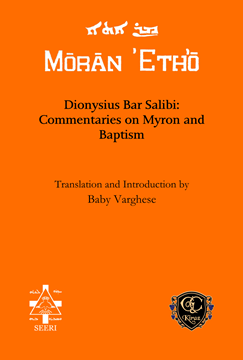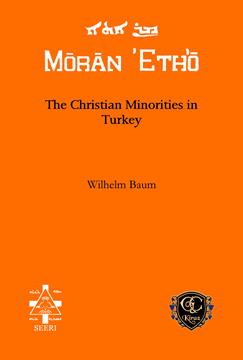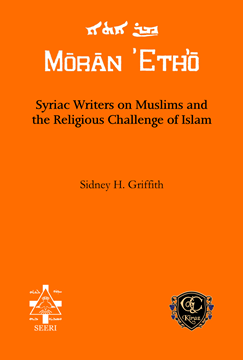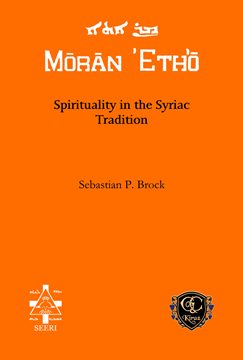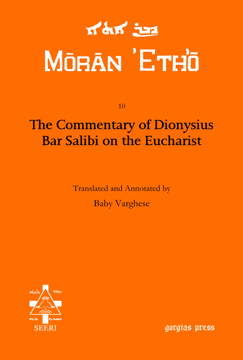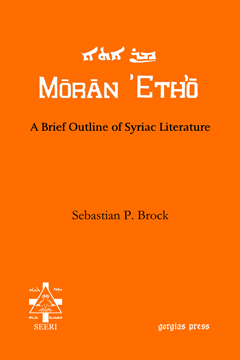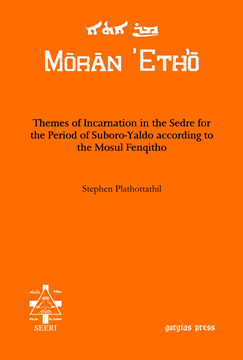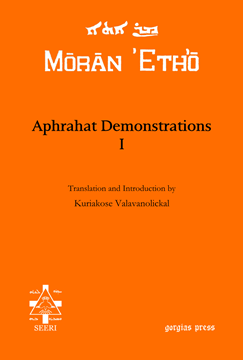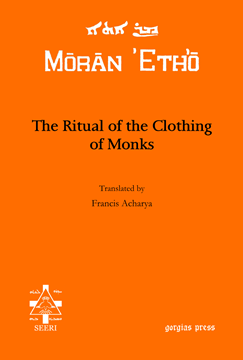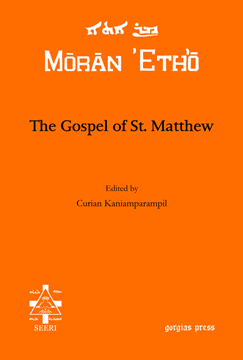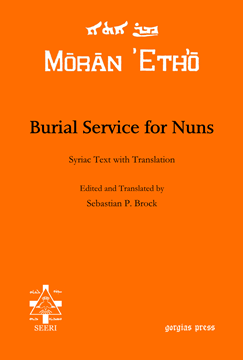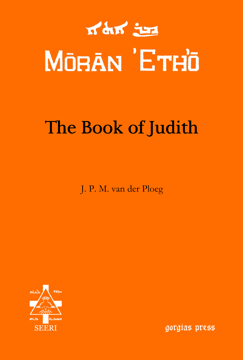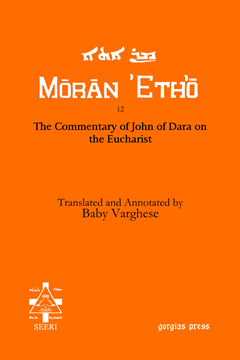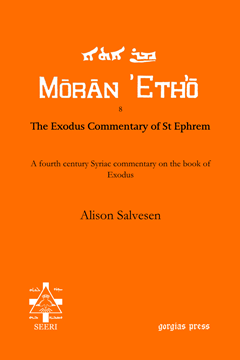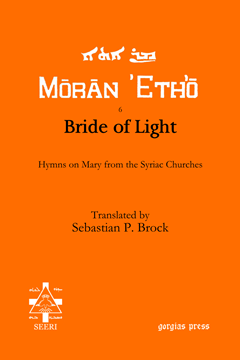Recently viewed products
Moran Etho
A publication of the St. Ephrem Ecumenical Research Institute (SEERI), the Moran Etho series provides short monographs and tools for the study of Syriac Christianity in all its traditions.
Commentaries on Myron and Baptism
Translation and Introduction by Fr. Baby Varghese
Series: Moran Etho
ISBN: 978-1-61143-578-8
In the present work, Baby Varghese presents the Syriac text, accompanied by an English translation, of Dionysius’s commentaries on the rites of myron (anointing of oil) and baptism.
$166.00 (USD)
The Christian Minorities in Turkey
By Wilhelm Baum
Series: Moran Etho
ISBN: 978-1-61143-577-1
In the present work, Wilhelm Baum provides an historical survey of the experiences of Christian communities in Turkey with a particular emphasis on the massacre in the early twentieth century.
$181.00 (USD)
Mariological Thought of Mar Jacob of Serugh (451-521)
Series: Moran Etho
ISBN: 978-1-61143-574-0
In the present work, James Puthuparampil surveys the appearances of Mary within the writings of Jacob of Serugh and attempts to construct the place of Mary within Jacob’s broader theological framework.
$208.00 (USD)
Syriac Writers on Muslims and the Religious Challenge of Islam
Series: Moran Etho
ISBN: 978-1-61143-562-7
Sydney H. Griffith provides a basic overview of Syriac authors that addressed the issue of Islam in their writings. Griffith discusses the major themes and common content of this literature and focuses on the dialogue genre.
$141.00 (USD)
Spirituality in the Syriac Tradition
Series: Moran Etho
ISBN: 978-1-61143-558-0
In the present volume, Sebastian Brock provides an introduction and overview of the unique themes and features of spirituality in the Syriac tradition and includes excerpts from various texts throughout the Syriac tradition that exhibit these features.
$162.00 (USD)
Aphrahat Demonstrations II
Translation and Introduction by Kuriakose Valavanolickal
Series: Moran Etho
ISBN: 978-1-61143-573-3
Kuriakose Valavanolickal presents here in two volumes the first English translation of the twenty-three Demonstrations by Aphrahat, the fourth century Persian Sage, who is one of the earliest authors of the Syriac tradition.
$131.00 (USD)
The Commentary of Dionysius Bar Salibi on the Eucharist
Translated and Annotated by Fr. Baby Varghese
Series: Moran Etho 10
ISBN: 978-1-61719-404-7
Bar Salibi’s commentary on the Eucharist is an invaluable witness to the history of the Syriac version of the anaphora of St James. Fr. B. Varghese provides here an English translation of the text.
$114.00 (USD)
A Brief Outline of Syriac Literature
Series: Moran Etho
ISBN: 978-1-61143-563-4
Sebastian Brock provides an overview of Syriac literature from the second to the twenty-first century. Brock divides this overview into six historical periods, surveys the important authors and writings of each period, and provides excerpts from some important writings.
$101.00 (USD)
Themes of Incarnation in the Sedre for the Period of Suboro-Yaldo according to the Mosul Fenqitho
Series: Moran Etho
ISBN: 978-1-61143-579-5
Stephen Plathottathil provides here a study of the liturgical prayers known as sedre corresponding to the portion of the liturgical year from annunciation (suboro) to nativity (yaldo).
$240.00 (USD)
Aphrahat Demonstrations I
Translation and Introduction by Kuriakose Valavanolickal
Series: Moran Etho
ISBN: 978-1-61143-572-6
Kuriakose Valavanolickal presents here in two volumes the first English translation of the twenty-three Demonstrations by Aphrahat, the fourth century Persian Sage, who is one of the earliest authors of the Syriac tradition.
$179.00 (USD)
Christliche Ikonographie
Series: Moran Etho
ISBN: 978-1-61143-569-6
Jean-Paul Deschelr presents a scholarly survey of the development and use of icons in the Christian tradition, including origins, recurring themes, and the technical aspects of creating icons.
$109.00 (USD)
The Ritual of the Clothing of Monks
Translated by Francis Acharya
Series: Moran Etho
ISBN: 978-1-61143-566-5
Abbot Francis Acharya presents an English translation and study of the liturgy for the ritual of the clothing of monks in the Syriac tradition that serves as the initiation for new monks into the monastic life.
$121.00 (USD)
The Gospel of St. Matthew
Edited by Curian Kaniamparampil
Series: Moran Etho
ISBN: 978-1-61143-564-1
Based in the rich poetic history of the Syriac language, Curian Kaniamparampil presents a metrical, poetic Syriac version of the Gospel of Matthew.
$123.00 (USD)
Burial Service for Nuns
Syriac Text with Translation
Edited and Translated by Sebastian P. Brock
Series: Moran Etho
ISBN: 978-1-61143-560-3
Sebastian Brock presents here the Syriac text and English translation of the liturgy for the burial of nuns in the Syriac tradition.
$111.00 (USD)
The Book of Judith
Series: Moran Etho
ISBN: 978-1-61143-559-7
In the present volume, J. P. M van der Ploeg presents the Syriac text and English translation of a previously unpublished recension of the book of Judith as found in an eighteenth century manuscript.
$114.00 (USD)
The Commentary of John of Dara on the Eucharist
Translated and Annotated by Fr. Baby Varghese
Series: Moran Etho 12
ISBN: 978-1-4632-0033-6
Baby Varghese publishes here an English translation of the Commentary on the Eucharist by John of Dara, a ninth century leader in the West Syrian tradition. This text is an important source for understanding Eucharistic practices in the ninth century.
$46.00 (USD)
The Exodus Commentary of St Ephrem
A fourth century Syriac commentary on the book of Exodus
Series: Moran Etho 8
ISBN: 978-1-61719-808-3
This commentary on Exodus by the highly influential fourth century Syriac writer St. Ephrem, is typical of his exegetical approach, particularly the emphasis on women in the narrative and the similarities to contemporary Jewish interpretations.
$43.00 (USD)
Bride of Light
Hymns on Mary from the Syriac Churches
Translated by Sebastian P. Brock
Series: Moran Etho 6
ISBN: 978-1-59333-845-9
Syriac is particularly rich in poetry on Mary. Not only is some of this of great tenderness and beauty, but much is also highly imaginative. The present selection of translations includes lyric poems (several by St Ephrem), five lively dialogues, and a longer narrative poem on Mary and Joseph.
$79.00 (USD)



